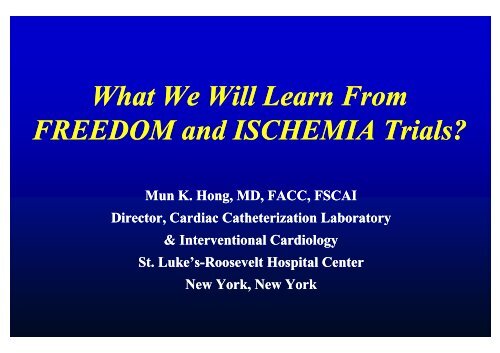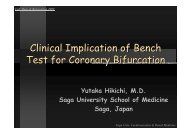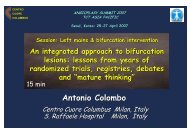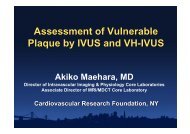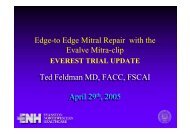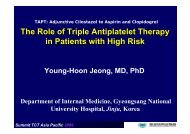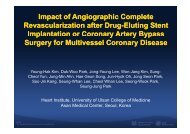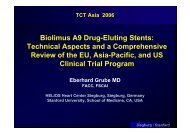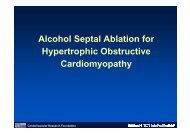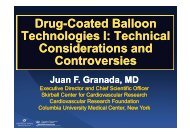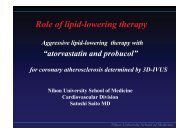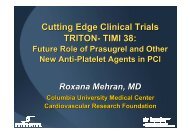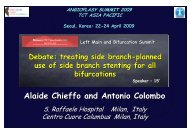ischemia trial - summitMD.com
ischemia trial - summitMD.com
ischemia trial - summitMD.com
Create successful ePaper yourself
Turn your PDF publications into a flip-book with our unique Google optimized e-Paper software.
What We Will Learn From<br />
FREEDOM and ISCHEMIA Trials?<br />
Mun K. Hong, MD, FACC, FSCAI<br />
Director, Cardiac Catheterization Laboratory<br />
& Interventional Cardiology<br />
St. Luke’s-Roosevelt Hospital Center<br />
New York, New York
What we would like to learn ≠<br />
What we are likely to learn<br />
Consequences =<br />
More confusion and<br />
reinforced biases
ISCHEMIA TRIAL<br />
International<br />
Study of<br />
Comparative<br />
Health<br />
Effectiveness with Medical<br />
and Invasive<br />
Approaches
PCI did not reduce death or MI<br />
in Stable IHD Patients<br />
1.0<br />
0.9<br />
0.8<br />
0.7<br />
0.6<br />
0.5<br />
0.0<br />
PCI + OMT<br />
Optimal Medical Therapy (OMT)<br />
Hazard ratio: 1.05<br />
95% CI (0.87-1.27)<br />
P = 0.62<br />
Number at Risk<br />
0 1 2 3 4 5 6 7<br />
Years<br />
Medical Therapy 1138 1017 959 834 638 408 192 30<br />
PCI 1149 1013 952 833 637 417 200 35<br />
Boden et al NEJM 2007
COURAGE Serial Nuclear Substudy:<br />
Out<strong>com</strong>es in 105 Patients ts with Moderate-to-Severe to e Baseline<br />
e<br />
Ischemia Who Returned for 2 nd Study @ 6-18 months<br />
A: PCI Reduces Ischemia Better<br />
than OMT Alone<br />
% of patients with mod-severe<br />
<strong>ischemia</strong> at baseline and<br />
significant reduction in <strong>ischemia</strong> at<br />
follow-up:<br />
PCI: 78%<br />
OMT: 52% (P=0.007)<br />
B: For Both Groups Combined,<br />
Ischemia Reduction Is Associated<br />
with Less Events<br />
Rate of death/MI over 3.5 years was<br />
16% among patients with significant<br />
<strong>ischemia</strong> reduction <strong>com</strong>pared with<br />
34% without<br />
C: Does PCI Reduce Events?<br />
1<br />
0.9<br />
0.8<br />
0.7<br />
0.6<br />
0.5<br />
0.4<br />
03 0.3<br />
0.2<br />
0.1<br />
0<br />
Cumu ulative Event-<br />
-Free Surviva al<br />
Unadjusted p=0.001<br />
Risk-Adjusted p=0.082<br />
≥5% Reduction in Ischemic<br />
Myocardium (n=68)<br />
16%<br />
34%<br />
No Significant Reduction in Ischemia<br />
(n=37)<br />
1.5 2 2.5 3 3.5 4 4.5 5<br />
Time to Follow-up (in Years)<br />
Shaw et al. Circulation. 2008;117:1283-1291.
ISCHEMIA TRIAL<br />
Chair‐ Judith Hochman, PI ‐ David Maron<br />
Co‐PI’s William Boden, Bruce Ferguson, Robert Harrington, Gregg Stone,<br />
David Williams<br />
• Patients: at least moderate <strong>ischemia</strong>, EF >35<br />
35%<br />
• Hypothesis: an initial invasive strategy of cath and optimal<br />
revascularization (PCI or CABG) + OMT is superior to a conservative<br />
strategy t of OMT alone with cath reserved for OMT failure<br />
• Composite Primary Endpoint: CV death, MI, or hospitalization for UA,<br />
resuscitated cardiac arrest, or heart failure (adjudicated)<br />
• Secondary Aim―Major: test hypothesis that invasive strategy improves<br />
angina-related QOL <strong>com</strong>pared with OMT alone<br />
• Sample Size: 8,000<br />
• Follow-up: average 4 years
Inclusion Criteria<br />
• Men or women 21 years or older who fulfill one of the<br />
following <strong>ischemia</strong> eligibility criteria:<br />
Nuclear Perfusion<br />
Echo/CMR<br />
Wall Motion<br />
CMR Perfusion<br />
≥10<br />
10%<br />
≥3/16 segments with stress- ≥12<br />
12.5%<br />
myocardium<br />
induced severe hypokinesis or<br />
myocardium<br />
akinesis
Exclusion Criteria<br />
• Unprotected left main ≥50% on pre‐randomization randomization CCTA or prior<br />
cardiac catheterization<br />
• LVEF50% stenosis) on pre‐<br />
randomization CCTA or prior cardiac catheterization with the<br />
previous 12 months<br />
• Unacceptable angina despite maximal medical therapy<br />
• ACS with the previous 2 months<br />
• PCI or CABG with the previous 12 months<br />
• Sustained or symptomatic VT<br />
• Stroke within the previous 6 months or ICH at any time<br />
• Unsuitable for PCI or CABG based on prior known anatomy<br />
• ASA, P2Y12 inhibitor, or heparin allergy<br />
• Contrast allergy that cannot be adequately pre‐medicated<br />
d
Exclusion Criteria<br />
• NYHA class III-IV IV heart failure at entry or hospitalization for chronic heart failure<br />
within the last 6 months<br />
• Non-ischemic cardiomyopathy/HCM<br />
• Severe valvular disease or valvular disease likely to require surgery within 5<br />
years<br />
• Planned surgery within the next 12 months<br />
• Life expectancy
Cath in Patients Randomized to CON<br />
• Cath will be reserved only for patients who have ACS or<br />
whose symptoms are refractory to OMT
ACCURACY OF NON-<br />
INVASIVE STUDY?<br />
CONFOUNDING O BY<br />
CROSS-OVER?<br />
OVER?<br />
EXCLUSION OF PATIENTS<br />
LIKELY TO BENEFIT<br />
FROM INVASIVE THERAPY?
What will we learn from the<br />
ISCHEMIA <strong>trial</strong>?<br />
• Initial invasive strategy for patients with stable<br />
ischemic heart disease does not appear to improve CV<br />
death, MI, or hospitalization for UA, resuscitated<br />
cardiac arrest, or heart failure.<br />
• This study will likely confirm the COURAGE overall<br />
results, even with moderate to severe ischemic burden.<br />
• The results will provide more armamentarium to<br />
further reduce referrals for invasive procedures.
What do we want to learn from<br />
the ISCHEMIA <strong>trial</strong>?<br />
• What is the best strategy to effectively treat patients<br />
with stable ischemic heart disease, considering all of<br />
the treatment options and risk/benefit?<br />
• Which group benefits from the initial invasive<br />
strategy?<br />
• When is the appropriate timing for “cross-over” over” for<br />
those patients initially managed with “optimal medical<br />
therapy”?
FREEDOM TRIAL<br />
Future<br />
REvascularization<br />
Evalution l i in patients with<br />
Diabetes mellitus: Optimal<br />
management of<br />
Multivessel disease
FREEDOM Trial<br />
Eligibility: DM patients with MV-CAD eligible for stent or surgery<br />
Exclude: Patients with acute STEMI, cardiogenic shock<br />
Randomized 1:1<br />
MV-stenting<br />
With Drug-eluting stents<br />
N=1200<br />
CABG<br />
With or without CPB<br />
N=1200<br />
All con<strong>com</strong>itant Meds shown to be beneficial are encouraged, including:<br />
clopidogrel, ACE inhibitors, ARBs, β-blockers, statins<br />
PRIMARY: 3-year death, MI, stroke<br />
SECONDARY: 12-month MACCE, 3-year Quality of Life
FREEDOM Trial:<br />
Superiority Trial<br />
• Primary out<strong>com</strong>e: Composite of<br />
– All cause mortality<br />
– Non-fatal lMI<br />
– Stroke
CARDia (Coronary Artery<br />
Revascularization in Diabetes) Trial<br />
JACC 2010;55:432-40<br />
40
CARDia Trial<br />
JACC 2010;55:432-40<br />
40
CARDia Trial<br />
JACC 2010;55:432-4040
ARTS Trials: 5-Year Out<strong>com</strong>e in<br />
Diabetic Subgroup<br />
DES (N=159)<br />
CABG (N=96)<br />
MACCE 40.5% 23.4%<br />
Mortality 9.0% 8.6%<br />
MI 40.5% 23.4%<br />
Repeat<br />
Revascularization<br />
33.2% 10.7%<br />
JACC Intervention 2011;1:317-323323
What will we learn from FREEDOM?<br />
• DES treatment is similar to CABG regarding the<br />
<strong>com</strong>posite endpoint of all-cause mortality, stroke, and<br />
non-fatal MI, thus disproving the superiority.<br />
• But there will be greater need for repeat<br />
revascularization in the DES group.<br />
• Consequence: Referring physicians will continue their<br />
preferred practice, with those believing in CABG refer<br />
more patients to CABG and those believing in<br />
percutaneous therapy continue to refer to the cath lab.
Whatwouldweliketolearnfrom<br />
we like to learn FREEDOM?<br />
• When is CABG preferred in<br />
diabetics?<br />
• Which group benefits more from<br />
initial DES treatment strategy?<br />
• What about hybrid revascularization?
If we knew what we were doing,<br />
it wouldn’t be research.<br />
Albert Einstein


